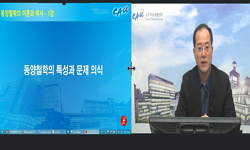This study is to illuminate the types of religions and rituals cherished by people in Gangdo, which was the capital in the period of Koryeo's struggle against Mongolia. Mt. Songak was the lord of mountains in Gangdo. Mt. Koryeo was the western tiger a...
http://chineseinput.net/에서 pinyin(병음)방식으로 중국어를 변환할 수 있습니다.
변환된 중국어를 복사하여 사용하시면 됩니다.
- 中文 을 입력하시려면 zhongwen을 입력하시고 space를누르시면됩니다.
- 北京 을 입력하시려면 beijing을 입력하시고 space를 누르시면 됩니다.
https://www.riss.kr/link?id=A101778913
- 저자
- 발행기관
- 학술지명
- 권호사항
-
발행연도
2005
-
작성언어
Korean
- 주제어
-
등재정보
KCI등재
-
자료형태
학술저널
-
수록면
1-37(37쪽)
- 제공처
- 소장기관
-
0
상세조회 -
0
다운로드
부가정보
다국어 초록 (Multilingual Abstract)
This study is to illuminate the types of religions and rituals cherished by people in Gangdo, which was the capital in the period of Koryeo's struggle against Mongolia. Mt. Songak was the lord of mountains in Gangdo. Mt. Koryeo was the western tiger and the Gap Cape was eastern dragon. Hwasan(Namsan) corresponded to a mountain as a table. The mountains spread through the center from the north to the south, forming Mt. Koryeo, Mt. Hyeolgu, Mt. Jingang, Mt. Jeongjok, Mt. Mari. These mountains became the objects of beliefs and were used as the places of rituals. Important places for Buddhist rituals in Gangdo were palaces and Buddhist temples. Every kind of Buddhist ritual was held mostly inner space of the main palace which might be located in the southern brink of Mt. Songak. It was also held separate or temporary palaces. The important Buddhist temples in Gaegyeng such as Bongeun , Beobwang, Boje, Geonseong, Bongnyeong, Hyenseong, Myotong were mostly restored, and new temples like Hyelgu and Seonwon were built. Most sites of those temples were not clarified. The location of Seonwon Temple was often argued, but it was regarded as the historic site ‘Seonwon Temple Site’. On investigation of several data Boje Temple was located in Seonheng village in the brink of Mt. Namsan. The Buddhist rituals of Gangdo were the yearly services, incensing ceremonies at Bongeun and Beobwang temples. The rituals of removing disaster and worshiping Srimahadevi, tutelar gods and In-Wang Prajnanaparamita Sutra were often held. The worship rituals for Buddhosnisa, Sakrodevendra, Mahavairocana, and Taoism God were held, which had a strong tendency to Esoteric Buddhism and Taoism. The King often visited Bongeun and Beobwang temples as yearly visiting events. He also visited Hyenseong, Wangnyun, Geonseong, Bongnyeng, Myotong, Woiwon, Boje temples. Very often the king went to Guyo shrine when the King visit Woiwon Temple. Guyo shrine was one of Taoism facilities, and Bongnyeong Temple had a taoism color. The Taoism rituals were actively held and the religious service for stars were performed in inner buildings of the palace and Chamseong of Mt. Mari. The united tendency of Esoteric Buddhism and Taoism was strong and the hermit of Ganghwa succeeded to eight hermits of Songak and beliefs of Tangun(the founding father of the Korean nation) derived from beliefs of Mt. Mari, Samnang wall, Sinni village.
동일학술지(권/호) 다른 논문
-
- 인천대학교 인천학연구원
- 오상학
- 2005
- KCI등재
-
- 인천대학교 인천학연구원
- 이정란(Lee, Jung-Lan)
- 2005
- KCI등재
-
- 인천대학교 인천학연구원
- 이성임(Lee, Sung-Im)
- 2005
- KCI등재
-
- 인천대학교 인천학연구원
- 배성수(Bae, Sung-Soo)
- 2005
- KCI등재





 DBpia
DBpia







